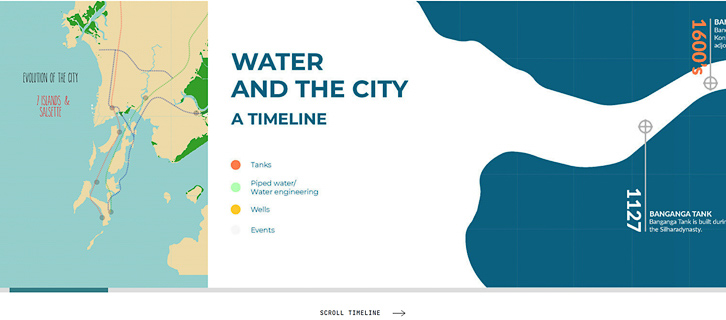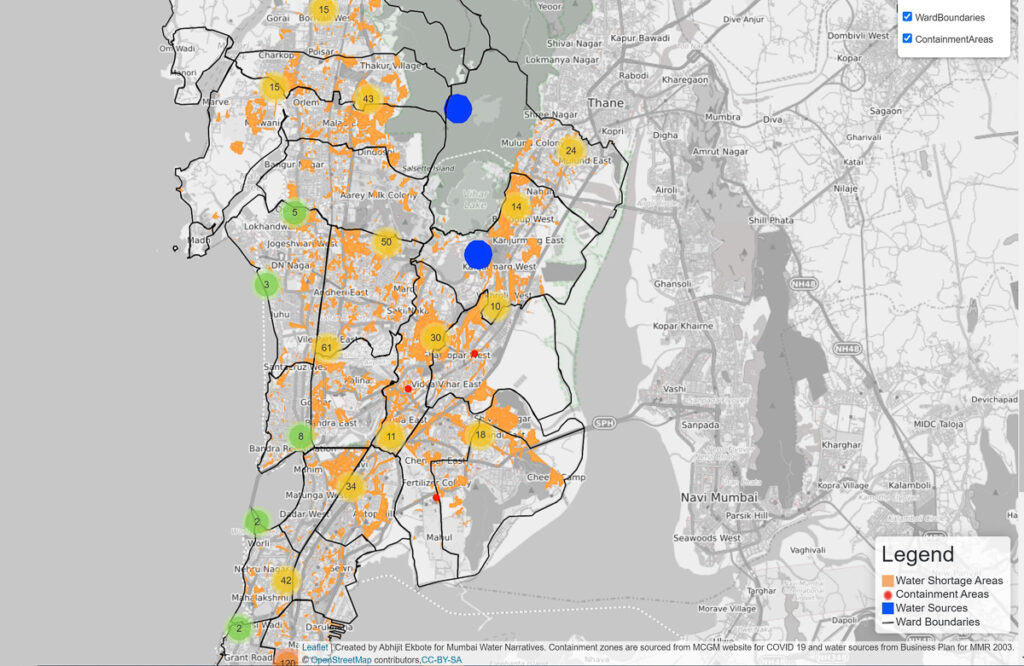Ipshita Karmakar and Sara Ahmed introduce a museum that honours the lifeblood of India’s most maximum city
In the midst of the constant smog, density and exhaustion of a developing city in the 21st century, a hundred-year-old sandstone water fountain, intricately carved but deteriorated and chipped, continues to dispense water to weary travelers. The ‘pyaav’ as it is colloquially known in Mumbai, is an oft-forgotten relic of the history of water sharing in the city. Wealthy philanthropists donated these water fountains as public services to the residents of the city, starting in the early 1900s when the technology of piping and pumping water had just been introduced. Today, these pyaavs stand in oblivion, one of several such forgotten narratives of Mumbai’s rich and indigenous water heritage.
Water has a multifaceted relationship with the city of Mumbai, from maritime trade to the traditional Koli fishing communities, from the tanker economy servicing high-rise apartments to the small water-sellers or bishtis in the bye-lanes of old Bombay, peddling water from leather pouches. But ask a citizen, especially from the privileged classes, where their water comes from, and they will typically reply that it comes from a tap or a plastic water bottle, unaware of the toil and turmoil that is hidden in those few precious drops of water that we take for granted. Recognizing this disparity, the Living Waters Museum, a virtual repository, initiated the Mumbai Water Narratives in July 2020, an informal collective aiming to document, curate and communicate Mumbai’s rich water heritage through a variety of media that could engage people of all ages and socio-economic groups, particularly children and youth.
In the midst of the raging pandemic which brought to the fore the heartbreaking fragility of human life, the Mumbai-based collective – initially a small team of three women- burgeoned into a partnership of over 40 water researchers, artists, conservation architects, photographers, designers, social scientists and urban planners. All passionate about water and leading experts in their fields, they pooled together their skills and knowledge with a sense of vigour and urgency to create their first virtual exhibition – ‘Confluence’, launched on the eve of World Water Day and marking a year since the lockdown in India.
Confluence is designed as six thematic digital galleries connected to water: Built heritage, culture and faith, livelihoods, saline waters, access to potable water and public health. Each gallery includes work by practitioners devoted to examining the history of water while charting future directions their chosen thematics would take. Featuring curated walks, panel discussions, films and music to begin a conversation on our shared waters, each gallery asks the viewers to reflect on our actions amidst growing structural inequality.
Using an interactive timeline with archival photographs, the first gallery on water and built heritage looks at how architectural manifestations of holding and sharing water via wells, tanks and fountains have dissolved into the current crisis of water scarcity via interactive timelines and photostories.

Minaz Ansari, Jinisha Lodaya, Ipshita Karmakar, Mehvish Sayed, Jovel Silva, ‘Water and the City: A Timeline’, 2020
Designed for children, the graphic story on Navi (new) Mumbai, a planned city, explores how it is possible to integrate an ecosystem approach sensitive to local livelihoods with urban development.
Water intersects with the diversity of cultures and faiths in Mumbai through myths, rituals and practices which question the notion of sacred and profane in our everyday lives as the second gallery on water and culture depicts. Using verses and quotes from our holy texts and stories on communities that have shaped the city, such as the Zoroashtrians (Parsis) and the East Indians, the gallery depicts the richness of the bonds with water that unite all of us.
The third gallery on water and livelihoods examines how economic profiteering and the commodification of water is affecting the livelihoods of those directly dependent on this vital resource – such as the inhabitants living at the edge of the rivers that course through Mumbai.
The impact of climate change on rising sea levels and the marine ecosystem forms the context for gallery four on saline waters which includes an interactive map of marine life from the city’s shoreline to the intertidal zone. A digital book documents narratives from women in the Koli fishing community through the dried fish recipes they have inherited. The book is beautifully illustrated by the artist Parag Tandel who is building an oral history archive for his community.
It is not possible to talk about urban waterscapes without reflecting on questions of access to water determined by the interconnections of caste, poverty, gender and faith in a teeming metropolis. The fifth gallery on water and equity looks at the struggles of the Pani Haq Samiti to obtain the right to water for informal communities (migrants, etc.) who do not necessarily own their homes.
And finally, the gallery on water and public health traces Mumbai’s history of waterborne diseases and the medical fraternity, as researched by Dr. Mridual Ramana with the infectious scrolls and words of the New Mexico based international artist Basia Irland. The gallery also includes an interactive map correlating coronavirus hotspots with water scarce areas in the city.
Confluence has established that the current public health narrative of isolation, sanitary quarantine and mistreatment of low income and marginalised groups, could have startling adverse effects on the already fraught water security of Mumbai. It is now, more than ever, that we learn from our shared histories, and re-imagine a safe and secure water future for all. Piece by piece, the complex and fragile relationship of Mumbai’s water ecosystem with people, marine organisms, culture, health and economy has emerged by connecting the work of this collective of artists, academics and professionals with each other. It speaks of the need to look at our water and land through a more integrated, interdisciplinary lens which recognises that the right to water is inclusive of all forms of life. Through interactive digital media, storytelling and multilinguality, the Mumbai Water Narratives collective seeks to guide and inspire our young water-keepers in this challenging journey.
About Ipshita Karmakar
Ipshita Karmakar graduated as an architect from Kamla Raheja Vidyanidhi Institute for Architecture and Environmental Studies, Mumbai, and will be joining the Massachusetts Institute of Technology for her Masters in City Planning (‘21- ‘23). She is a Fulbright-Nehru Master’s Scholar and JN Tata Scholar (2021). She coordinated the Mumbai Water Narratives exhibition as a part of the Living Waters Museum team. Her interest lies in stakeholder engagement and participatory planning, particularly geared towards building resilience to disasters and climate change within cities. Contact: ipshitakarmakar2212@gmail.com/ +9619911659
About Sara Ahmed
With more than 30 years of experience in water politics, gender and governance in South Asia, Sara Ahmed founded the Living Waters Museum in 2017 to engage youth through storytelling, art, new media and digital tools to re-imagine their water heritage. Currently housed at the Centre for Water Research at the Indian Institute of Science Education and Research, Pune, the virtual museum is creating narratives on new urban waterscapes in India through partnerships with schools, artists and researchers. Contact: sara.ahmed1981@gmail.com / +91-9810822362 / livingwatersmuseum@gmail.com










